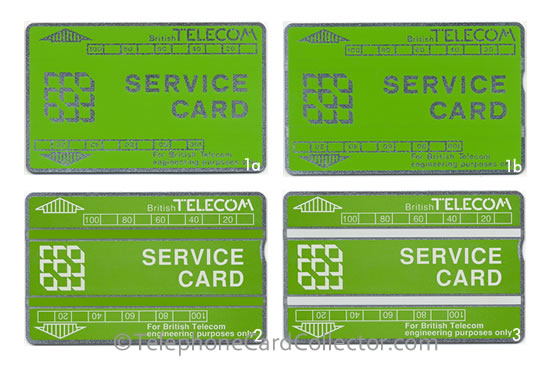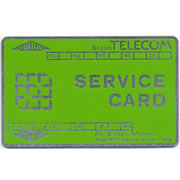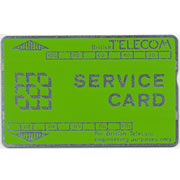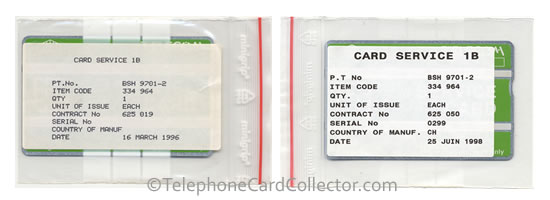British Telecom Service Cards
From the first British Telecom Service Card issued in 1981 right through to the last card produced in June 1998 British Telecom (BT) Service Cards were essential to the maintenance and running of BT's network of 39,000+ optical cardphones locations throughout the United Kingdom.
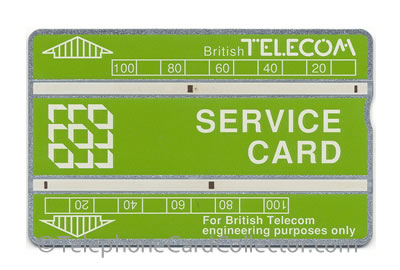
Pictured above - A used British Telecom Service Card, the card's design never changed in more than 20 years of use from the original issued in 1981.
The majority of BT's optical cardphones were replaced in 1996 when the new BT chip Phonecard technology launched, however a limited number of optical cardphones were in use until 2003/04 in UK prisons.
What is a BT Service Card and how do they work?
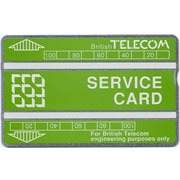 A BT Service Card is a telephone card issued internally by British Telecom to their payphone engineers who carry out maintenance and repair of the network of cardphone payphones both in public and closed user group locations e.g. HM Prisons.
A BT Service Card is a telephone card issued internally by British Telecom to their payphone engineers who carry out maintenance and repair of the network of cardphone payphones both in public and closed user group locations e.g. HM Prisons.
BT Service Cards (like the one pictured right) carries two optical strips of telephone talk time credit each with 100units per strip, a total of 200units.
Unlike most other BT Phonecards, Service Cards couldn't be used by merely inserting the card into the payphone card slot. Instead a Service Card could only be used when a BT engineer unlocked and opened up the cardphone payphone and then inserted the Service Card into the cards slot.
BT engineers used the Service Card to test the cardphone, ranging from making a call, to checking the burn rate of units on the card from a local and/or national telephone exchange.
The following is a list of different optical cardreader tests/operations that Service Cards were used for:
‣Test 1: Positioning the reading head track
‣Test 2: Setting the start position of the reading head
‣Test 3: Adjustment of the automatic power shut down
‣Test 16: Alignment of erase head to reading head
In addition to Service Cards, BT engineers and technicians also used Test Cards, learn more about BT optical and magnetic Test Cards.
Service Card design
On the face of it, and to the casual collector there are really only three different card designs. In fact between the years that optical Service Cards were in use, between 1981 to the early 21st century, the design of the card hardly changed in all of those years. These are the main three designs of BT Service Card that you will see.
‣1a - Green / Silver (no notch) - short or long track
‣1b - Green / Silver (with a notch)
‣2 - Green / White (off set print / green strip)
‣3 - Green / White (thermographic / white strip)
Pictured above - The three different British Telecom Service Card designs - from silver/green with green optical strip to white/green with white optical strip.
Although on the face of it (as pictured above) there are three different Service Cards - 1. green / silver, 2. green / white with green optical strips and 3. green / white with white optical strips, there are in fact five distinct cards to collect, these are pictured further down this page.
However, devule a little deeper (as some collectors like to) and you will find that issued between 1981 and 1998 there were in fact 45 different BT Service Cards. While these cards take the appearance of one of the above designs, turning the card over and reading the cards control number found on the reverse side, will confirm when the card was issued. This is the only way to confirm which batch/year a particualar Service Card originates from.
For example a Service Card with control number prefix (first three characters) 704S was produced in 1987, while another card with control number prefix 509L was produced much later in 1995. Learn more about BT Phonecard control numbers.
British Telecom Service Cards
All of the different BT Service Cards and there catalogue numbers e.g. BTS001 are shown below. To view a larger image simply click the picture of the card below.
The very first Service Cards used in the UK were reported to have been red cards designed for use with petrol pumps in Belgium and contained three optical tracks. It would appear that this cards were used as a 'transitional' card. These cards were reportedly used for the first engineering trials in Bristol and for training British Telecom Engineers. A similar green Belgium petrol pump card was also briefly used to service a couple of the first field trial cardphones in London. These cards were never in general use and therefore have never been listed in any of the UK catalogues.
The earliest BT Service and Test cards were made in Landis & Gyr's (L&G) factory in Zug, Switzerland. L&G records packing lists and shipments sheets between Zug and Acton for such cards. Probably all cards with 00 (demo) and 03 (early service / test) controls were produced only in Zug in order to avoid risks of duplicate control numbers. Subsequent Service and Test cards were certainly produced in L&G UK factory in Acton, London.
British Telecom Service Cards were issued in batches, each card within a batch was issued within a wrapper. The wrapper contained a label on the outside relating to the Service Card contained within.
The two examples below show that the Service Card on the left was manufactured on the 16th March 1996 (in the UK), while the card on the right was manufactured on 28th June 1998 in CH (Switzerland). Click the image below for a larger view.
Pictured above - BT Service Cards were issued in wrappers with batch numbers, date of manufacturer and other information.
Pictured below - BT Service Card with handwritten note.
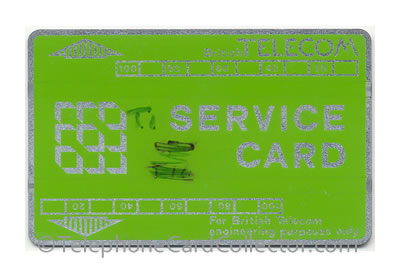
World Phonecard Catalogue UK 1 BT Service Cards Update
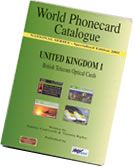 If you own a copy of the latest BT optical phonecard catalogue - World Phonecard Catalogue UK 1 (pictured right), you'd quite rightly think that the last BT optical Service Card was issued in 1995 on control number prefix 511L, but in actual fact a subsequent 'final' card was printed three years later in 1998 with a control number prefix 806L. This cards outer packaging/wrapper is pictured above right.
If you own a copy of the latest BT optical phonecard catalogue - World Phonecard Catalogue UK 1 (pictured right), you'd quite rightly think that the last BT optical Service Card was issued in 1995 on control number prefix 511L, but in actual fact a subsequent 'final' card was printed three years later in 1998 with a control number prefix 806L. This cards outer packaging/wrapper is pictured above right.
With the exception of the earliest British Telecom Service Cards, which were produced in Zug, Switzerland, the majority of BT's internal Service Cards were manufactured in the Landis and Gyr Phonecard factory in Acton, London, England. This included the final Service Card with a control number starting 511L to appear in the UK 1 catalogue. However, after the UK Landis and Gyr factory closed in 1996 and with optical cardphones still being used within the UK's Prison network, Service Cards were still required by BT engineers who serviced these closed network payphones.
It is believed a production run of 800 of these 'final' BT Service Cards were produced in Landis and Gyrs factory in Switzerland. The cards have a control number starting 806L, learn more about control numbers.
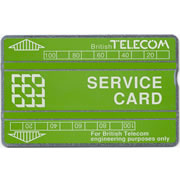 Service Cards wanted
Service Cards wanted
As a keen fusilatelist (telephone card collector), I'm keen to collect all the different Service Cards along with other BT Phonecards that were commissioned/produced for British Telecom to maintain the cardphone payphone network.
If you have any unwanted BT Service Cards to sell or giveway to me, I'd be very keen to hear from you. Please contact me via my contact page.
BT Test and Service Card Images - discover more on Pinterest
Follow Telephone Card Collector's board BT Test and Service Cards on Pinterest.Last updated: 2nd January 2026
Popular Pages
Collector Shop
Site Maps
TelephoneCardCollector.com © 2013-2026
Please do NOT copy any content without prior consent, thank you.


